Inventory : Products / Master Data: Products
Purpose
This document will briefly cover the product creation options in the Odoo 13 Inventory app.
First, please view the Product Creation Workflow document for best-practice tips. Additionally, please see our documentation on Warehouse Management to assign routes and default warehouse movements to your product once you have created it.
Debug Mode
Some steps and fields visible on the forms in this document will require you to be in Debug Mode.
Process
To get started, navigate to the Inventory app.

New Products
Go to Master Data > Products. If you have existing products, your initial view will be all existing products in the kanban view. Otherwise, you'll be prompted to create a product.
Click Create to add a new product.
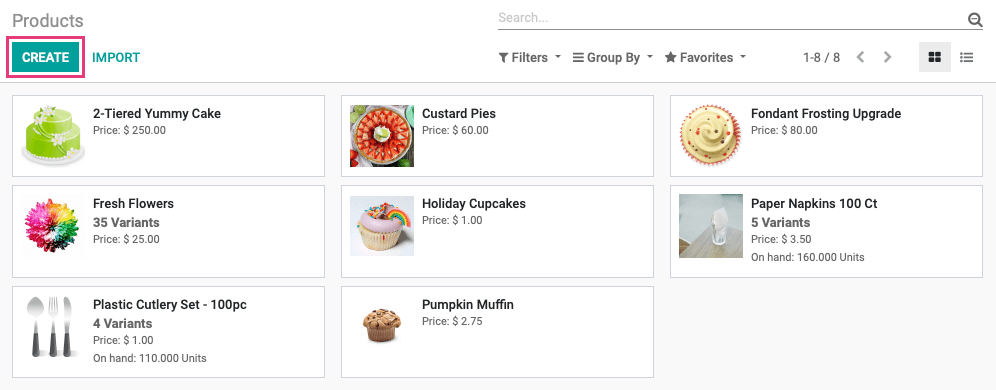
This opens the New Product form. Note that some tabs may only display if you have the corresponding applications installed (e.g. eCommerce).
Product Name: Enter the unique name for your product.
Can be Sold: Check this box if the product can be sold.
Can be Purchased: Check this box if the product can be purchased.
Image icon: Upload a product image.

Under the General Information tab:
Product Type: Select the product type from Storable (tracked stock), Consumable (not tracked), and Service.
Product Category: Select the category for this product.
Internal Reference: Allows you to set a custom unique reference, such as a SKU.
Barcode: If the Barcode app is installed, scanning a barcode with the digits entered here will pull up this product in POS and Inventory.
Sales Price: Allows you to set a default sale price for the item that will populate on sales orders. Use the Extra Prices button to add or modify pricing rules.
Customer Taxes: Pulls from the Accounting app to assign a tax rule to the item.
TaxCloud Category: Allows you to assign TIC categories, codes, and descriptions to your products to streamline tax collection.
Cost: If Standard Price, allows you to create a fixed cost for the purchase of the item. In Average and FIFO valuations, this field will be updated based on purchasing and other product movements.
Unit of Measure: The measure by which this item will be counted in inventory.
Purchase Unit of Measure: The measure by which the item can be purchased from vendors, (e.g. cases, dozens, units).
Internal Notes: This information will be displayed to internal contacts only.
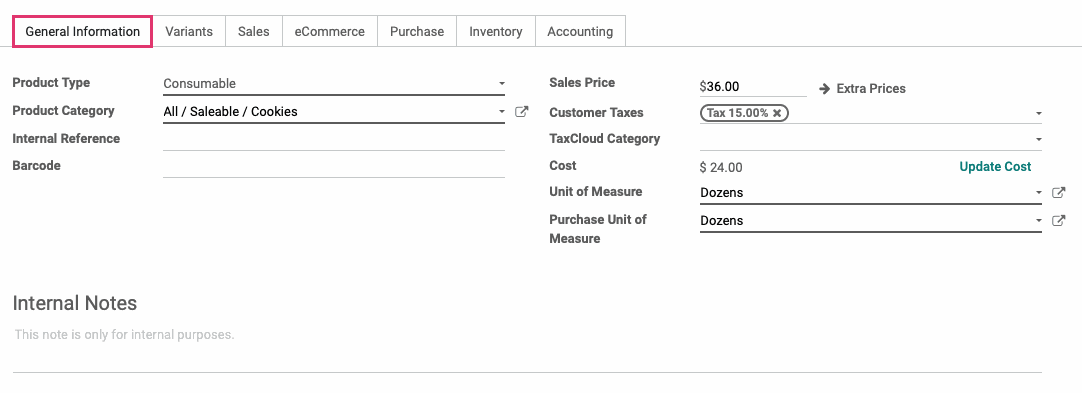
Under the Variants tab you'll see all configured variants for this product. For more information, see our documentation on Product Creation Workflow.

Under the Sales tab:
Invoicing > Invoicing Policy:
Ordered Quantity: Select this option to invoice this product when the order is placed by the customer.
Delivered Quantity: Select this option to invoice when this product is delivered to the customer
Automatic Email at Invoice > Email Template: Allows you to send a product-specific email once the invoice is validated
Options > Optional Products: These products will display to the customer and allow them to Add to Cart as a cross-sell strategy.
Sales Description: Text in this field will display on the sales orders and invoices.
Warning when Selling this Product: Select the type of message to display when a product is added to an invoice or RFQ.
Warning: This option will display a pop-up with the text you enter on the following line.
Blocking Message: This option will throw an exception, using the text you enter on the following line, and it will also block the flow of adding the product.
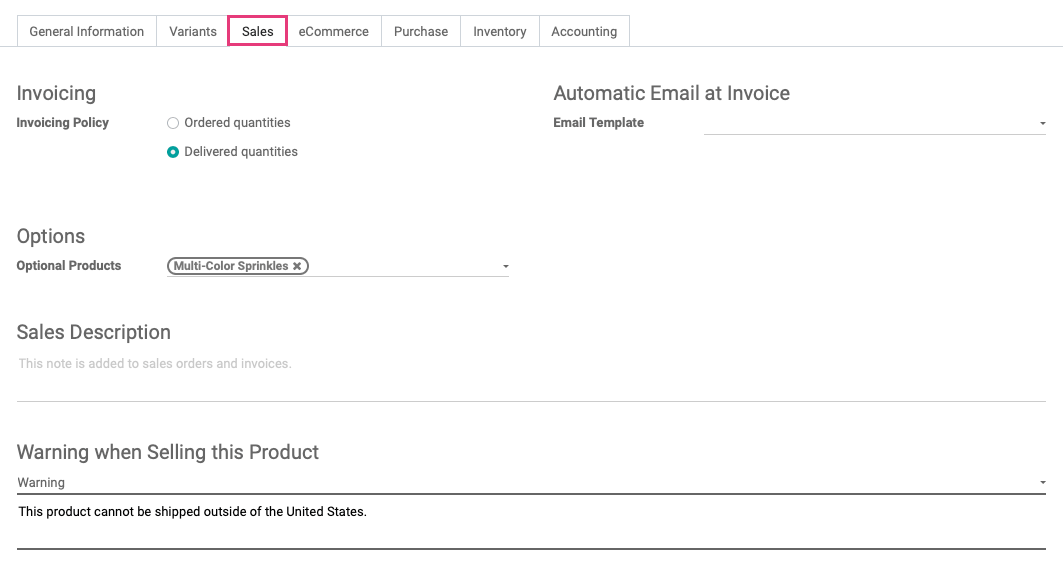
Under the ECOMMERCE tab:
Shop
Website Sequence: This sequence determines the display order on the website.
Categories: Select the category the product belongs to, this is purely for organizational purposes within the website.
Alternative Products: Suggest alternative products to your customers (Upsell Strategy)
Accessory Products: Suggest accessories to your customers when they review their cart before payment ( Cross-sell Strategy).
Styles: Choose a styled ribbon to appear on your product.
Extra Product Media
Add a Media: Allows you to add additional media whether it be pictures or videos that are relevant to your product.
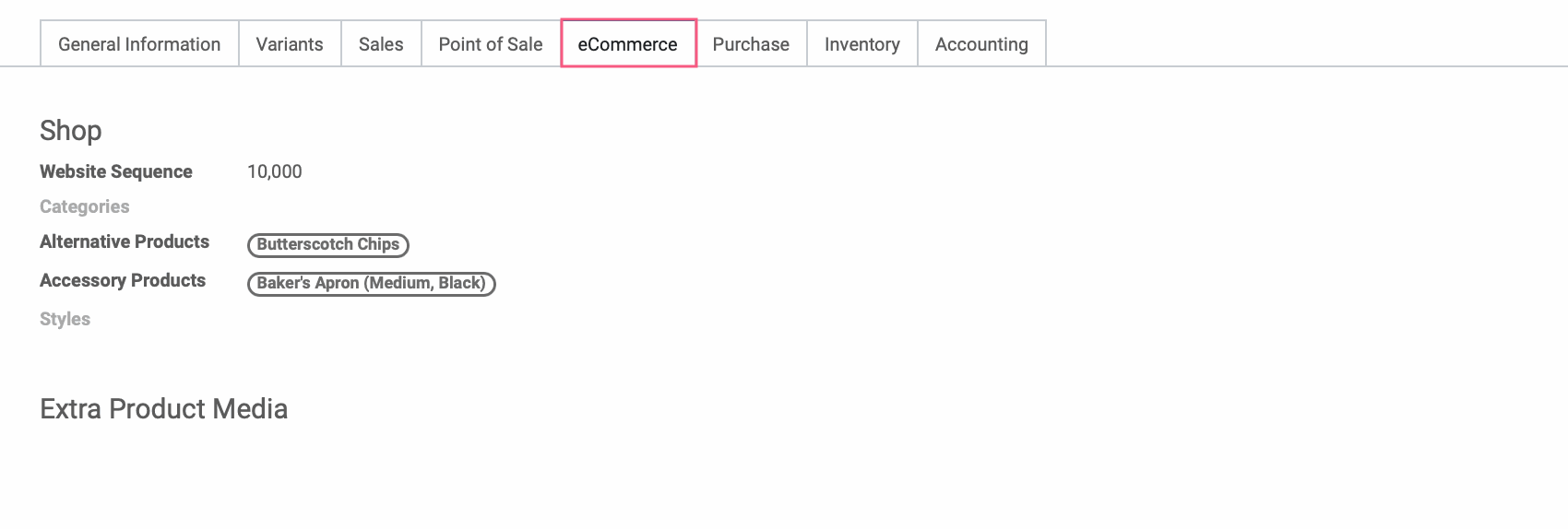
Under the PURCHASE tab:
Reordering > Procurement: Select the method of recording when this product reaches the minimum quantity on hand.
Create a draft purchase order: Based on your product configuration, the system will create a draft purchase order.
Propose a call for tenders: If the "purchase_requisition" module is installed and this option is selected, the system will create a draft call for tender.
Vendor Bills
Vendor Taxes: Enter applicable taxes for this product.
Control Policy: Select the method by which control bills are based.
Purchase Description: Select the type of message to display when a product is added to a purchase order.
Warning: This option will display a pop-up with the text you enter on the following line.
Blocking Message: This option will throw an exception, using the text you enter on the following line, and it will also block the flow of adding the product.
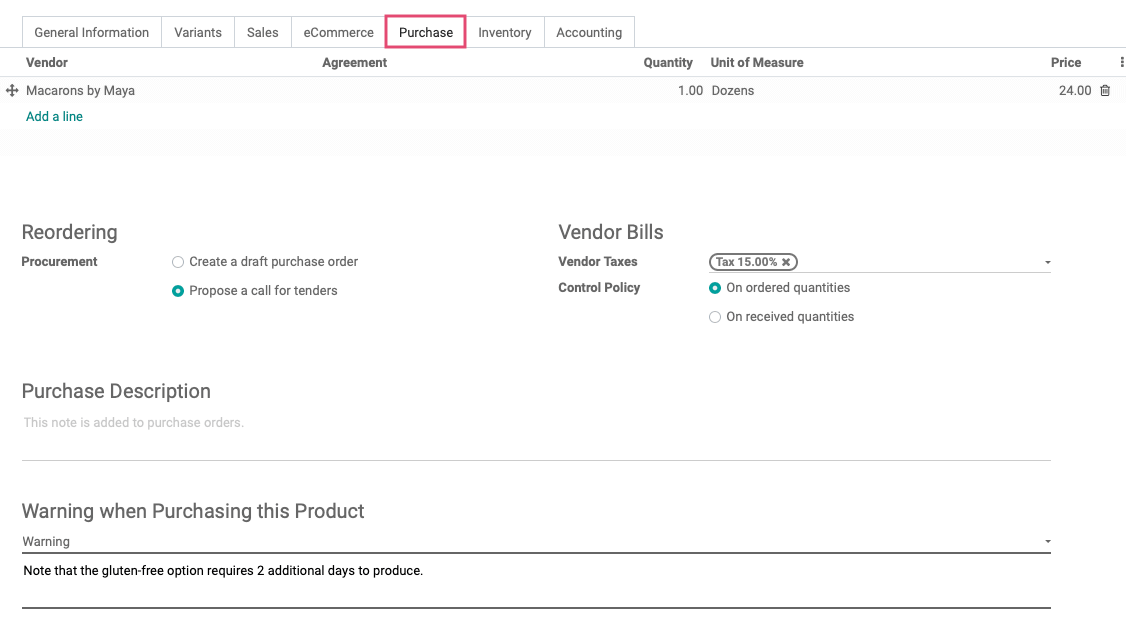
Under the Inventory tab:
Operations
Routes: Determine the routes by which this product is acquired, whether it is purchased, Made to Order, Manufactured, or some combination of the three choices. Note that checking the manufacture box will generate a manufacture order instead of a purchase order.
Manufacturing Lead Time: Enter the average lead time needed to manufacture the product.
Customer Lead Time: Enter the average lead time between order confirmation and delivery.
Logistics
Weight: Enter the weight of the product.
Volume: Enter the volume of the product, if applicable.
HS Code: Enter the HS code for international shipping and customs, if applicable.
Responsible: Select the contact responsible for this product.
Packaging: Create packaging data to aide in the tracking of inventory and how it is processed in your warehouse before being transferred to stock.
Description for Delivery Orders: This text will display on delivery orders.
Description for Receipts: This text will display on receipt orders (e.g. where to store the product in the warehouse).
Description for Internal Transfers: This text will display on internal transfer orders (e.g. where to pick the product in the warehouse).

Under the Accounting tab:
These fields are for reporting purposes and can all be left blank to use the associated default accounts.
Receivables: Determine the accounts for Income and Deferred Revenue
Payables: Assign the accounts for Expenses, Asset Types, and Price Differences.

Updating Quantities vs. Replenish
For storable products, There are two methods to adjust inventory from the product page. They are Update Qty on Hand and Replenish, located at the top of the product record.
Note: For this section, we've changed the product type on our example from Consumable to Storable.

Good to Know!
The Update Quantity and Replenish options will only display if the product type is set to Storable
Clicking Update Quantity will initiate the Inventory Adjustment feature. You can read more about this process in the Operations > Inventory Adjustments documentation.
Use the Replenish option to replenish your stock. Depending on your product configuration, launching a replenishment may trigger a request for quotation, manufacturing order, or a transfer.
A manufacturing order will require a bill of materials, covered in the next section.
Bills of Materials (BoM)
In order to manufacture a product, you will be required to create a bill of materials. Navigate to the product you wish to create and make sure that under the Inventory tab, the Manufacture box is checked.

In the top right corner of the product, click the smart button for Bill of Materials. It may be under the More dropdown if you don't see it immediately. This will only appear on manufacturable items.

This will take you to the Bill of Materials list. Once there, click Create and you'll see the following screen and options.
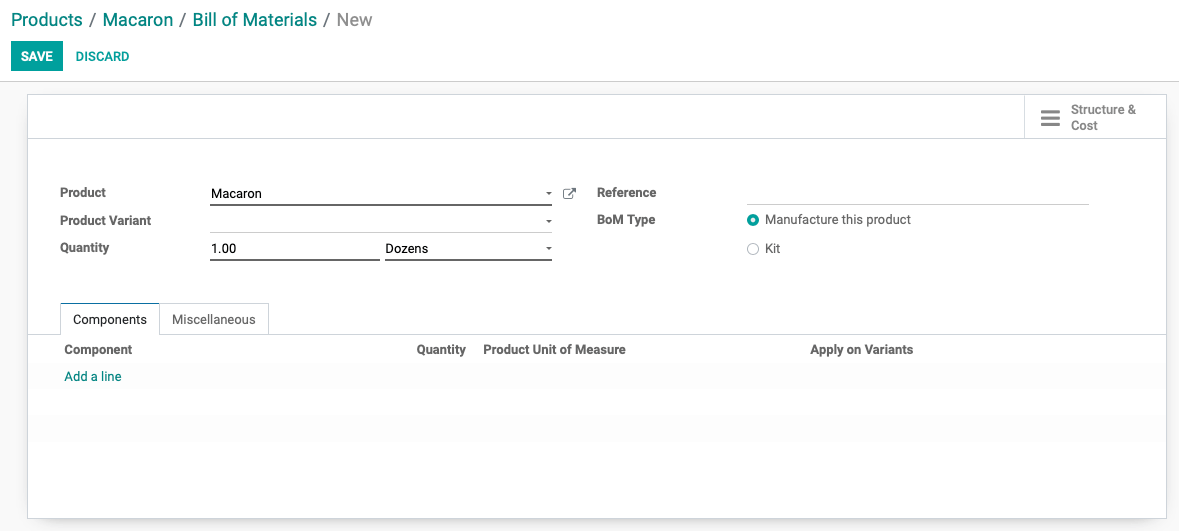
Every manufacturing "run" of this product will require a Bill of Materials. When you create a BoM, you will be asked to list the component products you need to use to create the item.
Product: Select the product to manufacture from the list.
Variant: Select the variant of the product that you are creating the BOM for
Reference: Give the BoM a reference ID such as “Original” or “v1”.
BoM Type
Manufacture this product: Select this option if the product needs to be created.
Kit: Select this option if the product is a compilation of other products already in your inventory that do not require production (e.g. accessory or cleaning kits).
Components Tab: If you've selected kit, click Add a Line to add the items from your inventory that create the kit.
Now, if a sales order is created and the product is not on hand, clicking REPLENISH on the product will generate a manufacturing order. This Bill of Materials can be referenced as the original, and duplicated for simple configurations, or created as needed to complete orders.
Importing and Exporting Products
The Import/Export tool is a great way to update multiple products at once. We recommend creating three or four products first and exporting them to use as a template.
To export, view your products in List View, then check the boxes on the products you will need. Use the topmost checkbox to select all products in the visible list.

You'll then need to select the type of data to export. Odoo makes it easy by offering you an import-compatible export. Tick this box unless you'd like to customize it differently.
Export Format: Select either XLSX or CSV format, depending on your preference.
Template: If you create a custom data export, naming the Template will make it easy to use in the future.
When you're satisfied with your settings, click Export. It may take some trial and error to learn how Odoo interprets its exported fields. Resist the temptation to rename the column headers, Odoo uses these to match the data to their respective fields on the product record.